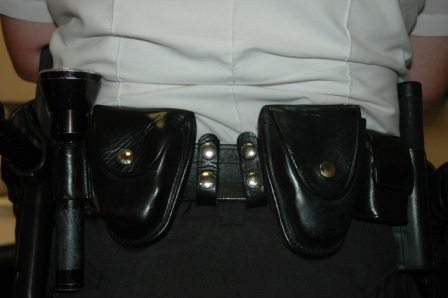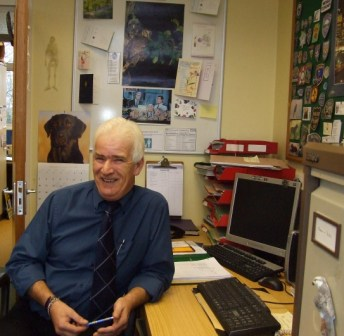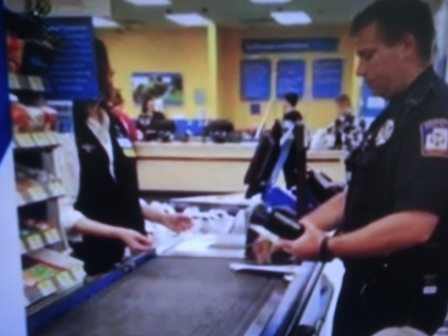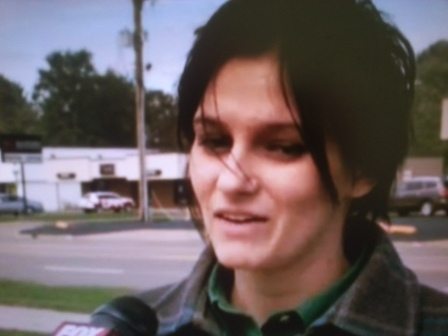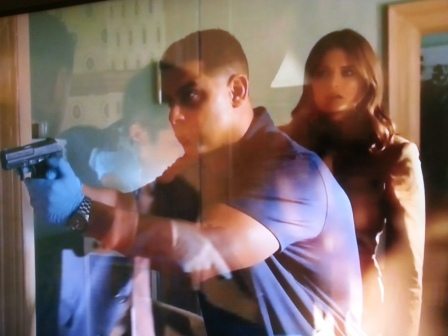After two weeks of bad Castle episodes, it was nice to see a glimpse of the “old Castle.” You know, way back when the show was fun. Right, Melanie?
Good cop Melanie reporting in. I’m smiling this morning, thanks to the hefty amount of Caskett in last night’s episode. Clear and Present Danger, a lighter episode with lots of laughs, gave us plenty of that. ‘Bout time!
I wasn’t watching at home, so I didn’t have the advantage of a DVR to rewatch scenes like I usually do. The bad weather distracted me, and the TV wasn’t the best. Yet I did manage to find a few key scenes online this morning, even if I haven’t had time for a full rewatch. That’s why my recap isn’t as detailed as usual. I’m having to rely on my memory, and it’s shaky at best.
I do, however, remember imagining Lee rolling his eyes at Lanie’s crazy supposition at the crime scene. Seriously? No wonder I focused on the Kate-Rick relationship.
Of course, along with their delicious PDA came frustration in the way of interruptions. These definitely get old after a while. I mean, is the phone going to ring every single time Kate and Rick start to get it on? And hey, if the phone didn’t ring, paranoia about the case kept them apart. Really? Just do it already.
Speaking of the case, I found parts of it hilarious, others ho-hum, and the rest made me look at my watch to see when we’d get back to the good part — Kate and Rick finally getting some uninterrupted alone time.
Of course, Kate and Rick’s encounter with the “invisible” man cracked me up. I found the premise far-fetched but loved the idea. Just wish the case part hadn’t gone downhill after this. I pretty much ignored it, just wanting to get back to Rick and Kate alone at the loft.
Thank heaven for Esposito, ragging Ryan about his new off-duty job. Those two made me laugh more than once. Then… enter Martha.
Leave her to get caught in Rick’s crazy “Zombie apocalypse” trap. So funny, and yet the trap itself left me shaking my head. I won’t get into the logistics of how long it must have taken for him to haul the pots and pans into the bedroom, tie the dental floss to the ceiling, and suspend the cookware in such a precise pattern… all while he’s in a hurry to get back to Kate. Didn’t seem believable, and yet it was funny and so Castle.
To summarize, I wasn’t thrilled with the episode as a whole but adored the renewed Kate-Rick dynamic. We finally got some much-needed PDA that made me feel as if their relationship is finally back on track. Hallelujah for that.
Next week’s “Kindergarten Cop” episode looks like more good fun. I only hope the case this time isn’t a yawner.
My turn, and you may be surprised to hear that I enjoyed this episode, sort of. Actually, this one just may be what it took to keep a few unhappy viewers/fans from switching off for good.
The show was fun, quirky, silly, and flirty, with a bit of murder tossed in for giggles. What made this episode work, at least for me, was how well the writers delivered a tale of believable make-believe. I was able to suspend belief/fact because Castle and crew were able to bring me inside their fictional world. And it’s hard to call someone a liar, even a fictional character, when you’re standing next to them, seeing exactly what they’re seeing.
To effectively deliver believable make-believe takes the combined efforts of both writers and actors. And that’s what we saw this week, a story told by writers who know their characters, and by actors who gave meaning and life to those same characters.
As a former contest judge (Best Episode in a TV Series) for a major entertainment-based organization, one of the things I watched for in the nearly overwhelming number of entries received each year, was the connection, or not, between the characters and the writers. Did the actors understand the characters and their story, or not? Did the actors understand the characters and their creators? Was the story believable? Were we, the audience, brought into the tale?
The failure of writer and actor to connect is a problem sometimes seen on shows featuring multiple writers—different writers for various episodes. Some writing styles seem to fit certain actors a bit better than they do others. When the “fit” is not there, well, it creates a bit of awkwardness that often finds its way on screen.
Even Lanie, with her witchdoctor mumbo-jumbo about the victim’s demise being caused by a punctured inferior vena cava, an internal wound she could not see while the victim was fully-clothed, was pretty decent in her attempt to help us believe fiction over fact. Well, there was that thing about the stress fractures of the victim’s hands. You know, the part where Lanie told us those injuries were proof that he’d caused all the damage to his own apartment, and that his injuries were a direct result of the destructive act. Why not a fall while bike riding, or mountain climbing? What about boxing, MMA, etc.? Yeah, that was a WTF line if there ever was one. Okay, maybe Lanie wasn’t much help after all.
Still, the pacing was good, and the characters actually seemed to be having a good time, once again. It was truly refreshing to see some relief from all the gloom and doom of previous episodes. Beckett, in fact, seemed to enjoy the “light” so much that she actually switched on a lamp prior to searching for evidence (cops don’t search places without some sort of light source). I also liked hearing Beckett’s comment about how she had to look at all angles of the case, no matter how “odd” they may seem at the time. She’s right. Investigators absolutely cannot rule out anything or anyone until fact says it’s so.
A couple of other good points from the show.
1) Cops, as a rule, do not earn a lot of money. Therefore, many officers work part-time jobs, including security. However, it’s unlikely that a department would permit an officer to work in a place that could be deemed unsuitable.
2) “You guys have the coolest toys,” Castle said to the chief scientist in charge of cloaking. I remember saying something similar years ago when I borrowed a piece of equipment from the FBI. Some of the things I saw there that day were, well, the coolest toys ever.
We’d love to hear your opinions. Did you enjoy this episode, or not? What was your favorite moment or line?






